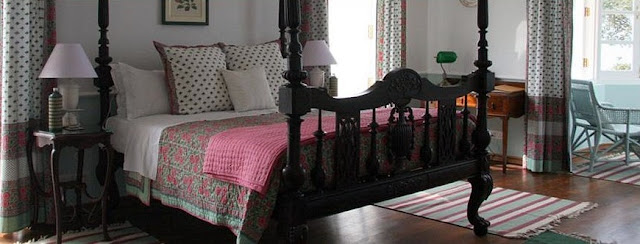Reading A Passage to India, which is set in India in the 1920s, reminded me of my love for British Colonial decor. The British colonies and trading posts around the world were first established in the 16th and 17th centuries and reached their peak in the 19th and early 20th centuries. At its largest, the British Empire covered approximately one-quarter of the world. It truly was the empire on which the sun never set. As British subjects were sent around the world to the colonies to govern, do business, and protect the home country's interests, they brought with them the traditional decor from home which they intermingled with local materials and styles and adapted them to suit the practical needs of climate and landscape. They produced a unique and beautiful blended colonial style.
In doing some reading about British Colonial decor, I've come up with eleven hallmarks of the style. I've tried to focus on this design style as it evolved and adapted to life in colonial India. So let's have a look at what features describe the Anglo-Indian design style:
1) Dark wood furniture and floors - Ebony, teak, and mahogany are all wood that is readily available in India and is often used, along with other native woods, to build furniture and houses. Frequently the furniture found in British Colonial rooms is traditionally British in style, but embellished with Indian design.
The following three photographs are from a working tea estate and now a hotel built in 1859 by the Scottish Tea Company in Darjeeling, India. The bedrooms are decorated throughout with antique dark wood furniture, some of which have the addition of Indian designs.
2) Light walls (white or pale colours) - The walls are often painted with light coloured reflective paint, providing a lovely contrast to the dark wood floors and furniture. The pale colours help make the rooms seem light and airy which is important, at least psychologically, to counteract the oppressive heat.
 |
| Inside Ronny's house on the set of A Passage to India (Source) |
3) High ceilings - Since heat rises, high ceilings help to keep the rooms cool.
4) Deep verandahs - These provide a cool place to retire to out of the sun.
5) Tall, rounded windows or garden doors - An elegant touch often found in British colonial decor.
 |
| The club from A Passage to India |
6) Fine accessories such as china, silver, or crystal - Traditionally, some of the elegant accessories would have been brought from England to provide a reminder of home far away and to help maintain a sense of keeping a proper English house. The sparkle of silver and crystal and the refinement of china lend a lovely contrast with some of the more rustic elements of wood and wicker found in British Colonial decorating.
 |
| Dining room from A Passage to India |
7) Woven elements - Floors are often covered with woven sisal or reed mats, baskets are used for storage, and caning is used in chairs and furniture. The natural colour of the woven elements provides a nice contrast with the dark furniture and floors.
8) Uniquely Indian elements - Many of the accessories used to decorate are from local artisans. For example, the addition of carved elephants and ornately woven cushions are typical of the Anglo-Indian style.
9) Flowers or greenery - Potted plants, ferns, and palms are placed around the verandas and used to decorate the interior of homes.
10) Ceiling fans or Punkahs (large swinging screen-like fans hung from the ceiling and swung by servants or machinery) - Some method of moving the air around was a necessity in the heat of India. Traditionally they used punkahs. But with the advent of electricity, ceiling fans came into use. Both methods evoke the Anglo-Indian decor style.
11) Hundi Bell Jar Lanterns - These are popular ceiling lights in British colonial homes.
****
I also found a few historic photographs that illustrate the decor. Notice in every photo there is a punkah hanging from the ceiling.
 |
Wealthy merchant's home, India, 1880 (source: Bombay Photo Images)
British Colonial decorating is a look I love! Any other fans of this decorating style? |
|
Linked to Inspiration Journey Linky Party at Modern Country Style






































0 comments:
Post a Comment